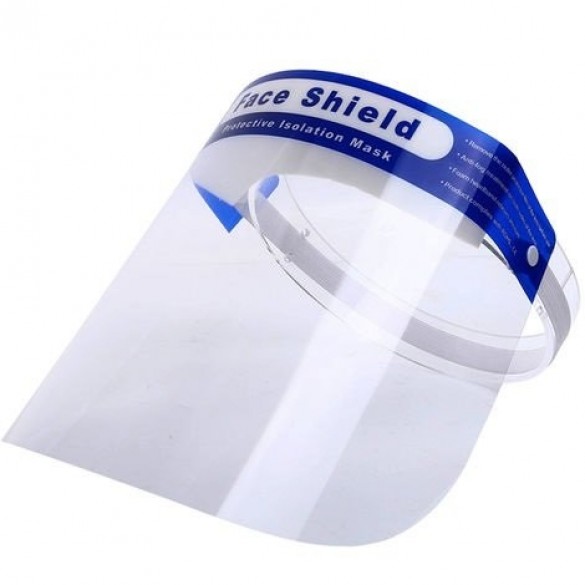Face shields are easier to talk in, but are they safer than masks?

Face shields may not be commonplace in all public spaces just yet, but as the novel coronavirus pandemic continues, more Canadians are considering the plastic protective face wear.
Plastic face shields are typically used in medical settings to protect health-care workers but are now being used in schools, restaurants and grocery stores in both Canada and abroad to help curb the spread of COVID-19, the disease caused by the virus.
“With face masks, there’s this lack of human connectivity and sense of anonymity when you only see the top part of someone’s face,” said Xenia Chen, founder of Threads, a tights company that sells non-medical masks.
“Face shields solve that issue.”
Using plastic face shields
In a recent opinion article published in the medical journal JAMA, three doctors out of Iowa argued that plastic face shields should be added to community COVID-19 prevention measures alongside contract tracing, handwashing and social distancing.
The doctors wrote that face shields “offer a number of advantages,” which include the fact that many models can be reused indefinitely and easily cleaned with household disinfectants.
Plastic face shields cover the eyes, nose and mouth — all areas where the novel coronavirus can enter the body. Droplets, expelled by sneezing or coughing, transmit the virus, meaning it’s important those areas are covered from both a spreading and exposure perspective.
“They are comfortable to wear, protect the portals of viral entry and reduce the potential for autoinoculation by preventing the wearer from touching their face,” the authors wrote.
“People wearing medical masks often have to remove them to communicate with others around them; this is not necessary with face shields.”
Research on face shields
While there is a lot of justified interest in face shields right now, said Dr. Lynora Saxinger, an associate professor of infectious diseases at the University of Alberta, it’s too early to suggest they be swapped for masks.
Government health officials recommend everyone wear a non-medical mask in public settings when physical distancing is not possible, as they help reduce the spread of any infectious droplets you may expel. Masks should fit securely, and non-medical masks should be regularly washed.
Having a non-medical mask or face covering has been a requirement for air travellers in Canada since April 20.
“There are a few droplet studies but no actual viral transmission studies that I have seen that clarify whether the face shield, with an open bottom and with airflow around the shield, is as protective as a mask,” Saxinger said.
“There are no studies comparing them (face shields) to masks because most real-world data we have is from health-care workers who are wearing both masks and eye protection.”
Saxinger points to a 2016 review on face shields for infection control.
The review concluded that due to the lack of a good peripheral facial seal, plastic face shields can allow for aerosol penetration. The paper concluded the equipment should not be used on its own, but rather alongside other personal protective equipment, like face masks.
Another 2014 study on the effectiveness of face shields used a coughing patient simulator and a breathing worker simulator to investigate the exposure of health-care workers to cough aerosol droplets.
Researchers found that a face shield reduced the inhalation exposure by 96 per cent immediately after the cough. But when a smaller cough aerosol was used, the face shield was less effective, blocking only 68 per cent of the cough.
As time went on, the shields were less useful.
“In the period from one to 30 minutes after a cough, during which the aerosol had dispersed throughout the room and larger particles had settled, the face shield reduced aerosol inhalation by only 23 per cent,” the researchers wrote.
Based on these findings, Saxinger said, it appears that “smaller particles can remain in the air and flow around the face shield,” meaning they should not be used as a “stand-alone measure in a space with an ill person but likely are quite helpful if someone is coughing in your face.”
The importance of properly wearing face coverings
Face masks or face shields must be worn properly in order for them to be most effective.
The doctors who argued for shields in the JAMA article said the plastic coverings “should extend below the chin anteriorly, to the ears laterally, and there should be no exposed gap between the forehead and the shield’s headpiece.”
Chen said face shields may pose a practicality problem to much of the population. She said many Canadians have grown accustomed to wearing face masks in public, as they are easy to slip into pockets or purses when you leave the house and need to take them on and off.
“Face shields are bulkier and less convenient for the general public,” she said.
At Thread, Chen is adjusting her non-medical mask designs to meet customers’ needs. Masks can make it challenging to clearly communicate and hear people speak, which is something manufactures are working on solving.
“We’ve recently added more fabric to the middle of our masks, so there’s more give, to allow for more space between the mouth and the mask,” she said.









Comments